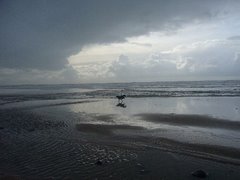
Last week Russian TV showed venerable grey-haired academics unveiling a monument to Laika , the pioneering dog that led the way to manned spaceflights on November 3rd, 1957, near the city's Military Medicine Institute by laying flowers. The U.S. space program relied mainly on tests with primates in its early stages, a fact derided by Russian scientists. "Monkeys are very ill-mannered -- they try to clutch whatever they can, they fancy they can switch whatever they want," Vladimir Ponomarenko, head of a space and aviation academy, said with a smile. "But the dog is a friend of humans and is easy to train." The dogs chosen for the Russian space program were usually stray mongrels as it was believed they could survive and adapt in harsh conditions. Also, small dogs were chosen as they could fit into the capsule and were light for launch. Two year old Laika was apparently chosen from the animal shelter in Moscow for her good looks. After all, the first Russian into space would need to be photogenic. There was intense excitement about her selection for participation in the space race and she endeared herself to scientists and the public; she was described as "quiet and charming". In my blog entry of 27th July 2007, I described how poor Laika must have suffered.
http://eurodogtraining.blogspot.com/2007/07/let-us-not-forget.html







3 comments:
Wouldn't it be more appropriate to name a star after her?
Well I'm glad she has achieved recognition at last but this post brought tears to my eyes again. I was really upset at the time we found out too.
Yes, I remember that post. Poor little thing.
Post a Comment